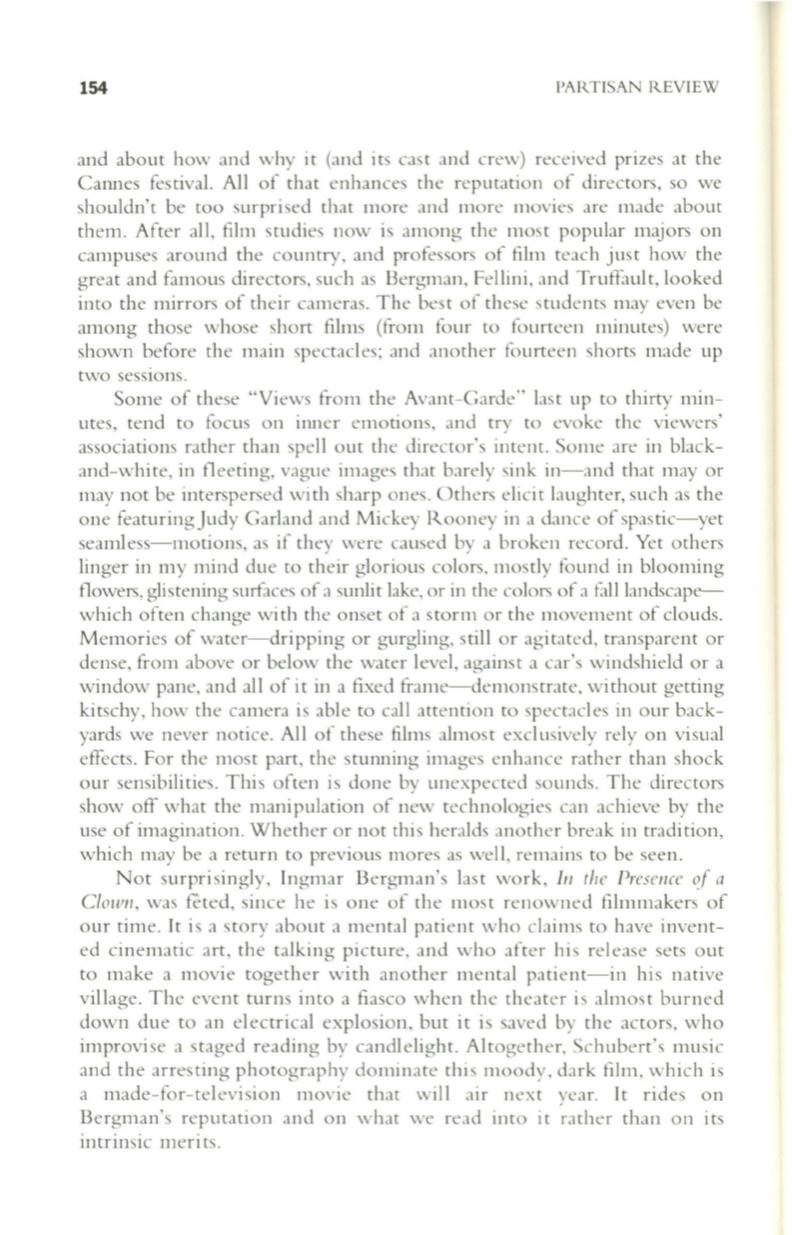
154
PAl1..TISAN REV IEW
and about how and why it (and its cast an d crew) received pri zes at the
Cannes fes tival. All of that enhances the repu ta tion of di rectors, so we
shouldn't be too surpri sed that more and mo re movies are made about
them. After all , film studi es now is among the mos t popular majors on
campuses aro und the country, and pro fessors o f film teac h just how the
great and fa mous direc tors, such as Bergman , Fellini , and Tru ffa ult, looked
into the mi rrors of their cameras. T he bes t of th ese students may even be
among those whose short films (from four to fo urteen minutes) we re
shown before th e main spectacl es; and anoth er fo urteen sho rts made up
two sessions.
Some of these "Vi ews from the Avant-Ga rde" las t up to thirty min–
utes, tend to foc us o n inner emoti o ns, and try to evoke the viewers'
associations rather than spell out the director's intent. Some are in blac k–
and-white, in fl eeting, vague images th at ba rely sink in-and that mayor
may not be interspersed with sharp ones . O thers eli cit laughter, such as the
one featuri ng Judy Ga rl and and Mi ckey R ooney in a dance of spas tic-yet
seamless-moti ons, as if they were caused by a broken reco rd. Yet others
linger in my mind du e to th eir glorio us co lors, mos tl y found in blooming
flowers, gli stening surfaces of a sunbt lake, or in the colors of a fall landscape-–
which o ften change wi th th e o nset of a storm or the movement o f clouds.
Memori es of wa ter- dripping or gurgling, still or ag itated, transparent or
dense, from above or below the water level, aga inst a ca r's windshi el d or a
window pane, and all of it in a fi xed frame-demons tr3te, w itho ut ge tting
kitschy, how the camera is abl e to call attenti o n
to
spectacles in o ur back–
yards we never noti ce. All o f these films almos t excl usive ly rely o n visual
effects. For th e mos t part, the stunning images enhance r3ther than shock
our sensibilities. T hi s o ften is done by un expected sounds. T he directors
show off what the manipul ati on of new tec hnolog ies ca n ac hi eve by the
use of imaginati on. Wh ether or not thi s heralds another break in traditi o n,
which may be a return to previ o us mo res as well , remains to be seen.
N ot surpri sin gly, In gmar Bergman's las t wo rk ,
III th e Presellce of a
CIOllll1,
was fe ted , sin ce he is o ne of th e most renowned filmmakers o f
our time.
It
is a sto ry about a mental pati ent who cla ims to have inve nt–
ed cin emati c art, th e talking pi cture, and who after hi s release se ts o ut
to make a movie toge th er w ith ano th er mental pati ent- in hi s na ti ve
vi ll age. T he eve nt turn s into a fi asco when th e th ea ter is almos t burn ed
down due to an electr ical expl osion, bu t it is s3ved by th e ac tors, w ho
improvise a staged read ing by candleli ght. Altoge th e r, Schubert's music
and th e arres tin g photogr3phy dominate thi s moody, dark film , w hi ch is
a made-for-te levision mov ie that w ill air nex t year.
It
ri des o n
Bergman's rep utation and on what we read into it rather th an on its
intrinsic merits.


